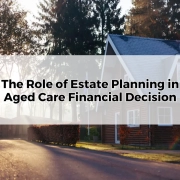Can You Negotiate RAD and DAP Rates? Tips and Tricks
Table of Contents
ToggleNavigating the financial aspects of aged care can be challenging, especially when dealing with Refundable Accommodation Deposits (RADs) and Daily Accommodation Payments (DAPs). These two primary methods for funding aged care accommodation significantly impact a family’s financial planning and quality of life. RAD is a lump sum payment that residents pay upfront, which is refundable upon leaving the facility or passing away, while DAP is an ongoing daily payment that doesn’t require an initial deposit. Each option has implications for cash flow and long-term wealth management, making it essential for families to approach these decisions with knowledge and strategy. By understanding these fees, families can make informed choices that align with their broader financial objectives, preserving capital where possible and ensuring peace of mind. For many, the question then arises: are these rates negotiable? And if so, how can families secure the best possible arrangement?
What Determines RAD and DAP Rates?
RAD and DAP rates are influenced by a variety of factors, each shaping the cost structure of aged care accommodation. The primary determinants include the location of the facility, the level of care provided, the amenities offered, and the quality of accommodation. For instance, facilities in metropolitan areas or prestigious locations may command higher RADs or DAPs due to elevated property values and operational expenses. Similarly, higher levels of care and specialised services like memory care or extensive nursing staff can drive up costs. Amenities such as private rooms, landscaped gardens, or gourmet meal plans can also impact fees. While the basic daily fee and means-tested care fees are set by the government, RAD and DAP are largely determined by the individual provider, which allows for some degree of flexibility in how they are priced. Understanding these variables can empower families to make comparisons and, ultimately, to approach negotiations with realistic expectations.
Is It Possible to Negotiate RAD and DAP Rates?
Contrary to popular belief, RAD and DAP rates are not always set in stone. While not all facilities openly advertise negotiable rates, there is often room for discussion, particularly in instances where a facility has unfilled rooms or is in a competitive location. Negotiating RAD and DAP rates may be especially feasible in regional or less sought-after areas where providers may be more inclined to secure residents. The aged care industry operates within a dynamic market where supply and demand play a crucial role; this means that opportunities for negotiation can arise. However, the degree of flexibility varies, and families should approach negotiations with a realistic understanding that not all providers will be open to discussions. Armed with knowledge about factors influencing pricing, families can identify scenarios where negotiation may be welcomed by providers looking to maintain or increase occupancy rates.
When to Start Negotiating Rates
Timing is everything when it comes to negotiating aged care accommodation costs. Beginning discussions before the need for urgent placement often yields the best results, as families can research options and gauge providers’ openness to flexibility. Engaging in negotiations early also allows more time to review terms and payment structures without the pressure of imminent placement. Facilities tend to appreciate proactive discussions, especially when families demonstrate genuine interest and commitment. Waiting until the last minute, on the other hand, may limit negotiating power as providers can leverage the urgency of a vacancy. By initiating conversations sooner rather than later, families can avoid pressure-based decisions and instead focus on securing arrangements that support their financial and care needs in the long term.
Know Your Rights
Australian residents entering aged care facilities are protected by specific consumer rights and legislation, which supports fair treatment and transparency in fee structures. The Aged Care Act 1997 establishes guidelines for providers, ensuring that they offer clear information about costs, services, and accommodation options. Residents and families have the right to request detailed cost breakdowns and, importantly, to be informed of any potential changes in rates. This legal framework provides leverage during negotiations, as providers are obligated to maintain transparency and can’t arbitrarily increase fees without reason. Familiarising oneself with these protections empowers families to negotiate from a position of strength, knowing that Australian law supports their right to fair and honest discussions around fees.
Evaluating Facilities
Before entering any negotiation, it’s essential to evaluate a facility comprehensively. The quality of care, staff-to-resident ratios, accessibility, and additional services are all aspects that contribute to the value of a particular facility. Touring the facility, observing staff interactions, and assessing the cleanliness and comfort of communal areas offer invaluable insights into what the rates truly represent. Comparing facilities based on these criteria helps to identify where value is offered and, conversely, where a provider may lack competitive offerings. In many cases, demonstrating that you have done due diligence and are aware of alternative facilities can strengthen your negotiating position, as providers may adjust rates or offer incentives to secure your choice.
Understanding the Role of the Aged Care Means Test
The means test is an essential factor in determining RAD and DAP rates, as it assesses a resident’s assets and income to calculate contributions towards care. For those whose financial assets exceed certain thresholds, a means-tested care fee may apply, which can increase overall costs. Understanding the nuances of this assessment is crucial because it affects eligibility for subsidies and other financial assistance, which, in turn, influences negotiation leverage. For instance, a higher means test assessment may reduce the appeal of a large RAD, as this ties up funds that could otherwise be used to offset daily fees. Knowledge of how the means test impacts overall cost will assist families in exploring various payment methods and crafting a negotiation strategy that aligns with their financial circumstances.
Approaching the Facility with Confidence
Negotiation requires confidence and preparation. Approach facilities with a well-informed mindset, showing familiarity with their fee structures and the broader landscape of aged care costs. Being assertive yet respectful is key; families should feel empowered to discuss fees openly without hesitation. Prepare to ask direct questions and seek clarification on any ambiguous terms, as providers are legally obligated to be transparent. Establishing a confident tone signals to providers that you have researched the field and are aware of alternative options, which can increase their willingness to discuss rates and payment flexibility. A clear and assertive approach can help in achieving more favourable terms without compromising on care standards.
What to Ask When Negotiating RAD and DAP
Knowing which questions to ask can streamline negotiations and clarify areas for potential flexibility. Essential questions include: “Are there any discounts available for upfront RAD payments?” or “Is there an option to switch between RAD and DAP depending on financial needs?” These questions help reveal whether the facility is willing to accommodate different payment arrangements or offer incentives for certain payment methods. Inquiring about annual fee increases and any additional charges that may apply can also protect against unexpected future costs. By establishing a clear understanding of available options, families can assess which payment structure aligns best with their financial situation, ultimately aiding in decision-making.
How to Leverage Financial Advice in Negotiations
Seeking the expertise of a financial adviser specialising in aged care can be invaluable when negotiating RAD and DAP rates. Advisers understand the intricacies of aged care fees and can often pinpoint areas where savings are achievable. They can also provide insight into structuring payments to maximise cash flow, minimising financial stress. For instance, an adviser might recommend a strategy that balances RAD and DAP payments based on a client’s unique financial goals. With a specialist on hand, families are better equipped to negotiate from a position of financial insight, which may reveal options otherwise overlooked.
Alternative Strategies If Negotiation Isn’t Successful
Not all negotiations will yield the desired results. If a facility remains firm on its fees, exploring alternative payment structures or different facilities may provide a solution. Some families find that partial RAD payments combined with DAP can offer a balance, reducing upfront costs while managing daily cash flow. Another option is to consider facilities slightly outside the desired location, as regional centres often offer more competitive rates. The willingness to adapt and reconsider options ensures that families are not cornered by high costs, providing flexibility that may ultimately prove advantageous.
Conclusion
Planning for aged care accommodation is a complex journey that requires careful consideration and informed negotiation. By understanding RAD and DAP rates and exploring negotiation opportunities, families can structure their approach to achieve favourable financial outcomes. Proactive discussions, supported by comprehensive knowledge of rights, facility standards, and payment strategies, enable families to make decisions that align with long-term goals. A well-prepared approach reduces financial stress, allowing families to focus on their loved one’s comfort and care with confidence and peace of mind.









